Please use the following link to download the September 26, 2020 issue of the syəcəb

syəcəb
Please use the following link to download the September 26, 2020 issue of the syəcəb

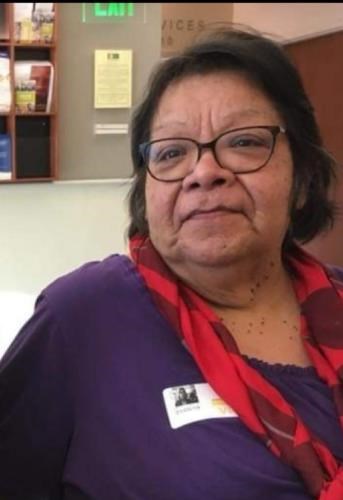
1951 – 2020
On Thursday, September 17, 2020, Dolores “Annette” Medcalf, loving wife, and mother of three passed away at age 68.
Annette was born November 4, 1951 in Seattle, WA. On March 14, 1969 she married Joe “Corky” Medcalf. She took care of many people as a home care aid for many years. They raised three children, son Kalonie, and two daughters, Theresa and Elizabeth “Mimi”, and granddaughter Kailene. Although there are many who call her Mom.
Annette was a loving and caring woman. She made friends wherever she went. She was smart, witty, and always ready to smile and laugh. She was an excellent cook and a crafty creative person.
Annette is preceded in death by her mother, Rose and several beloved brothers and sisters. She is survived by her husband, Corky; children, Kalonie, Theresa and Mimi; grandchildren, Kailene, Mayson, and Zoie; great-grandchildren, Joey and Jaycee; brother Charles Blatchford; sisters Molly (Tamur) Zahir, and Leona Ward.
A funeral service will be held Friday, Sept. 25, 2020 at 10:00 AM at the Tulalip Gym in Tulalip, WA with burial to follow at the Mission Beach Cemetery.
November 4, 1951 – September 17, 2020
By Micheal Rios, Tulalip News
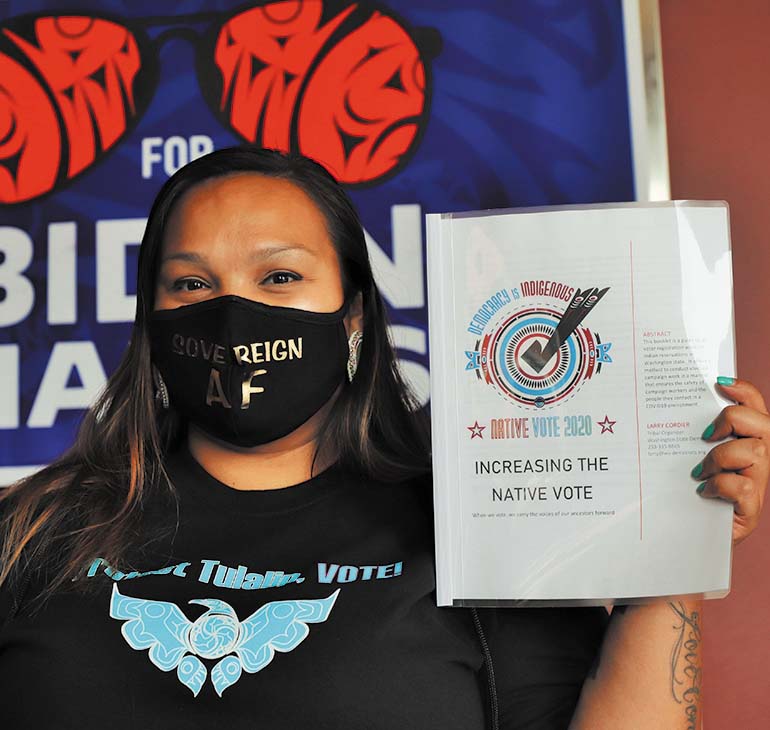
“As Native people, we are born into politics. Our ancestors fought and died, not only for our survival, but also to determine how our people would live generations into the future. As tribal members, you have rights defined by the treaties that your chiefs negotiated with the federal government,” stated Larry Cordier (Lakota), tribal organizer for Washington State Democrats.
“In recent years, Washington tribes have had a resurgence of culture and tradition. The return of the canoe journey, language, and food sovereignty are examples of the priorities the tribal councils have placed in determining the future of their Nations,” he continued. “That work must continue. We are working hard to elect candidates and partners who support tribal sovereignty and self-determination.”
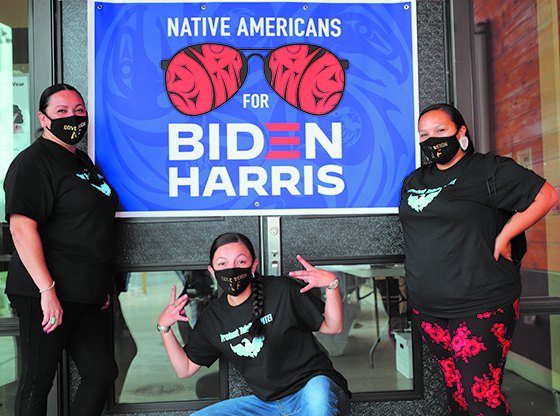
Larry’s words rang out at the Don Hatch Youth Center on Friday, September 18, during a Democrat-sponsored, ‘Get Out the Native Vote’ community event. The mission was to make it as convenient as possible for non-registered, eligible Tulalip voters to get registered to vote in the upcoming presidential election.
Such was the case with Tulalip tribal member Jaydin Thompson Sheldon who turned 18-years-old this past summer. Becoming a full-fledged U.S. adult citizen right before a presidential election was not lost on the Marysville-Getchell graduate, as she expressed a sense of perspective few her age rarely do.

“It was important to me to get registered today so I can have a say in elections. Not just for president, but local and state elections, too,” reflected an optimistic Jaydin moments after registering to vote and collecting a stylish Native Vote 2020 t-shirt. “It’s become a trending topic with my friends on social media, so I’m hopeful a lot of people my age will vote. Because I’m new to politics there is a lot of research I need to do to determine which candidates reflect my values.”
While voters like Jaydin aren’t willing to commit to either major party or their high profiled candidates, there is a growing consensus from Tulalip leadership that a Biden/Harris ticket is the only way to go in order to protect treaty rights and strengthen tribal sovereignty.
Married couple Lavinia and George Contraro expressed something similar to the ‘blue no matter who’ mantra because they feel the current president doesn’t deserve a second term.
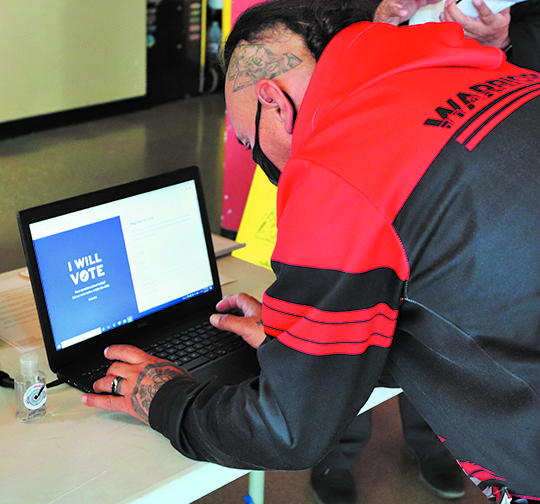
“It’s been a while since I’ve voted,” shared George. Event staff assisted him filling out the necessary forms so that he can come out of voter hibernation and cast a ballot come Election Day. “It’s important I vote now because we need Trump gone.”
“It’s only common sense. Everyone has to vote for Biden if we’re going to get Trump out of office,” added his wife, Lavinia. She was able to check her voter registration and get it updated with her current address.
Concluding the afternoon event, staff noted they successfully assisted 14 tribal members get registered to vote.
“This is a huge success. If we got only one person registered it would have been a success, and to get fourteen is just that much more significant,” said Board of Director Misty Napeahi. “Hopefully, everyone we got registered today will talk to other people they know who aren’t registered and let them know how easy the process is.
“This election may be the most important election of our lifetime!” she continued. “Historically, we’ve been told our vote doesn’t matter because that’s how Republicans win elections, though voter suppression. When we the people get out and vote, Democrats win. That’s why it is so important that this election every Native vote be counted.”
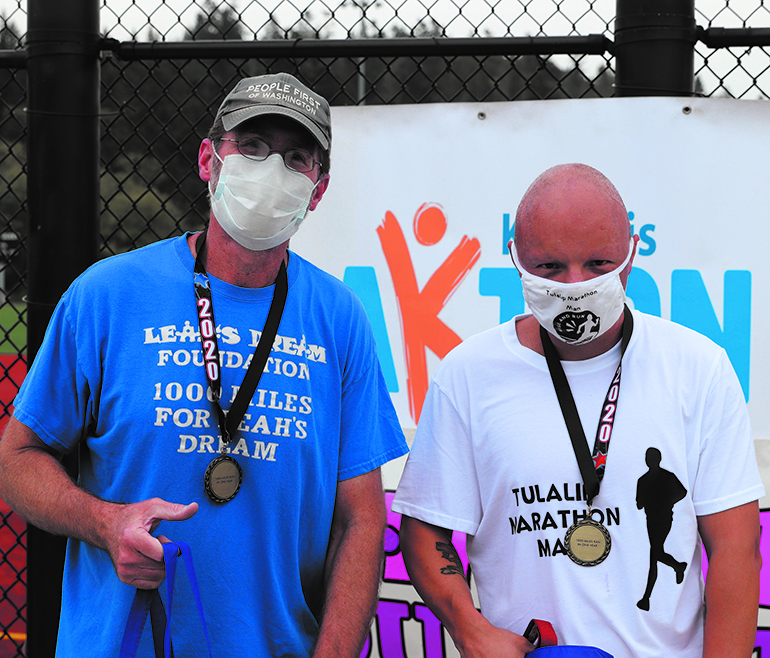
By Kalvin Valdillez, Tulalip News
“Nobody in my family was a runner,” said Tulalip tribal member, Tyler Fryberg. “But once I was able to run my first three miles without stopping, that got me excited and I kept on running ever since.”
Tyler’s passion for running began during a big change in his life, when making the transition from middle school to high school. Knowing he wanted to participate in school sports, he signed up for cross country and track & field during his freshman year at Lake Stevens High School. He continued competing in both sports his sophomore year before transferring to Monroe High School where he completed his school career.
“When I left Lake Stevens and moved to Monroe, where I graduated, it was all new,” he said. “I started there my 11th grade year and I did both cross country and track. I didn’t make varsity for cross country my first year there, but I did for track & field. After my 11th grade year, I end up lettering in both sports during my senior year. That was my goal I had all along, even with knowing I had a disability and that it was going to be a lot harder than the normal person.”
After lettering in cross country as well as track & field, and also receiving his diploma, Tyler set new goals to crush and kept lacing up his running sneakers every single day to begin training for the Special Olympics. Due to his hard work, Tyler medaled nearly every year he competed at the Special Olympics and even carried the Special Olympics Torch of Hope for 18 miles in 2012.
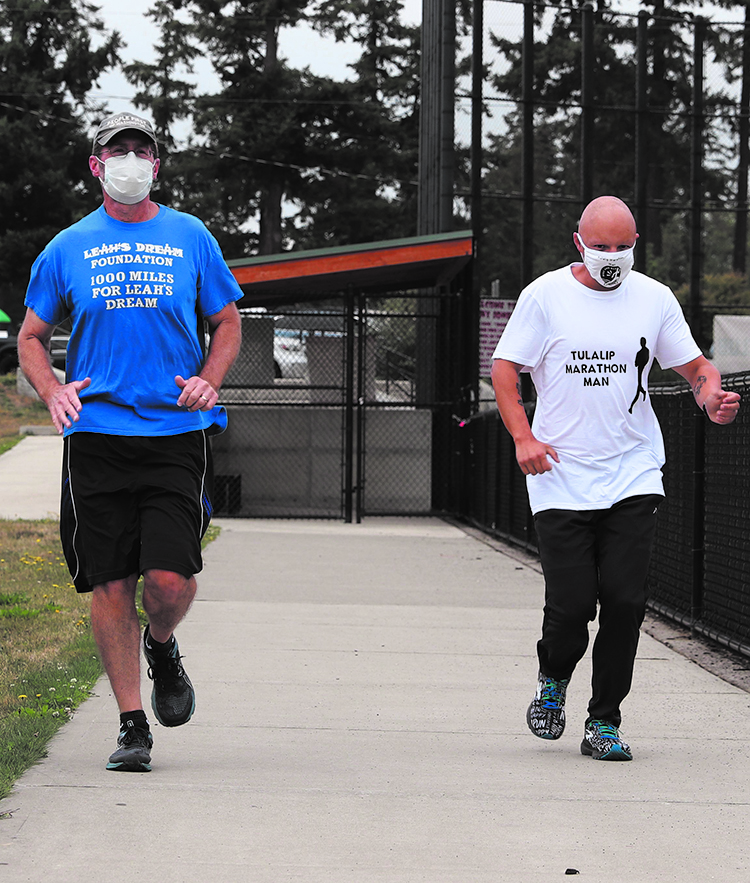
Now age 28, Tyler has run for over half of his life, with the exception of a one-year hiatus due to an injury, “that really got me thinking about my body, taking care of it better so I can run longer,” he expressed.
With countless miles under his belt and several accolades to show for his love of running, Tyler is constantly looking for new challenges, new opportunities to push his limits and exceed his own personal goals. When he learned about a former teacher, Jim Strickland, partnering with Tulalip-based non-profit, Leah’s Dream Foundation, to help raise money and promote awareness for children with disabilities, it was the perfect match.
“I was already involved with Leah’s Dream,” he stated. “So, when they decided to make the Miracle Mile Challenge, I said right away that I definitely wanted to be a part of it. When I signed-up, there was a lot of different miles you can choose from. For me, I like to make big goals so I picked 1,000 miles. That journey started January 1st and was supposed to end on December 31st, but I actually finished my 999th mile a couple weeks ago.”
Finishing months in advance, Tyler ran between 3.5–5 miles for six days every week of the year, making sure to take a rest day to recover and prepare for the upcoming week. On top of the Miracle Mile challenge, Tyler has competed in Special Olympic events such as virtual races, that are held online due to the COVID-19 pandemic. Tyler also created a Facebook page to keep his fans and supporters updated during the challenge and his upcoming running endeavors.
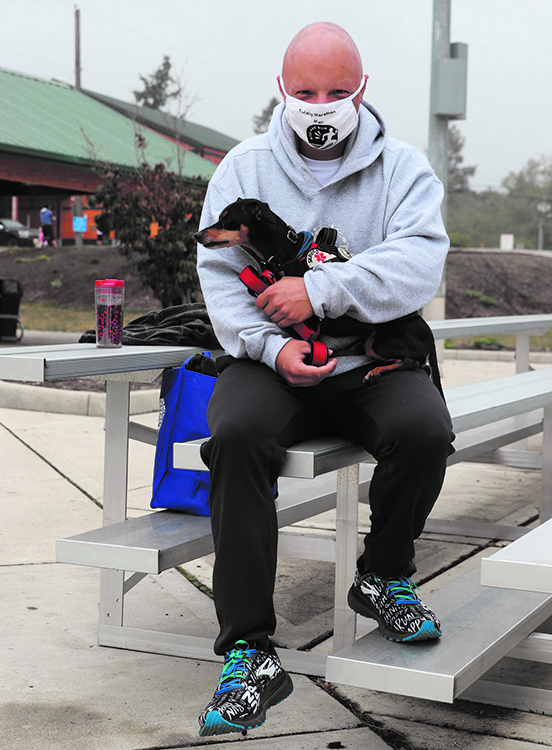
“Somedays I feel motivated, and there are times I don’t feel like running at all,” Tyler admitted. “But this challenge is for Leah’s Dream and knowing that, it gave me motivation to run every day and it was actually something I looked forward to and was excited to do.”
Leah’s Dream Foundation was established in 2015 with one major objective in mind, inclusion. The foundation was started by Deanna Sheldon and family when her daughter, Leah, was diagnosed with autism. The profits that the foundation raises go towards parties, gifts and activity packages for children and young adults living with autism and special needs, to help build a sense of community amongst the youth and their families. Some of their most popular events include the Leah’s Dream Foundation Annual Golf Tournament and the summertime Special Needs Field Day, complete with bouncy castles and a BBQ.
“Before the pandemic, we used to host community events where families all across our community would come together,” Deanna explained. “It was always a free event; we had food, arts and crafts, activities, and events. Last year around this time, Mr. Strickland said he wanted to raise money by running 1,000 miles in one year, and wanted to offer people the chance to do it with him. He’s a runner and is so inspirational.”
Added Amy Sheldon, Leah’s Dream Board Member and Deanna’s sister, “Mr. Strickland was actually Kelsey’s teacher. Kelsey’s my daughter, she’s 24 years old and has autism. He is the one teacher that she had a lot of comfort in, she only had two that she really liked in high school and he was one of those. He would think outside of the box to help her. He’s an inspiration and goes above and beyond for our community.”

Jim Strickland is an instructor at Marysville Getchell High School and has worked throughout the Marysville School District, assisting young adults with developmental disabilities transition to a life outside of high school.
“I’ve worked with people with disabilities my entire career,” Jim said. “I teach the transition program at Marysville Getchell High School, helping people with disabilities transition from school to active roles in their community. I always had a passion for creating a community that was truly inclusive so that everybody has a place, is valued and is able to share their skills and abilities, whatever they might be. That’s my dream come true, and this played right into it. Leah’s Dream is really about that.”
He continued, “We were looking at a way to raise awareness for Leah’s Dream Foundation and to also raise funds. A lot of my students have been the beneficiaries of the projects that [Leah’s Dream Foundation] has done here in the community. Since Tyler and I both like running, we decided to do a running challenge and I set my sights high for 1,000 miles. Of course, Tyler’s an animal and he’s got other races he’s involved with, so his running went really fast. I had to pick up the pace. Turns out we were able to finish 999 miles sooner than we expected, so we wanted to have a celebratory last-mile-run together and hopefully put the word out and get some more contributions for Leah’s Dream.”
On the afternoon of September 19, upwards of forty people gathered at the Tulalip Sports Complex, located outside of the Tulalip Youth Center. The two participants readied themselves in a running position and the crowd began to count them down. At 1:00 p.m. on the dot, Tyler and Jim took off and began their final mile side-by-side.
A young man practicing drills on the football field with his family learned about what was happening and immediately began jumping up and down, cheering on the runners, especially Tyler. The young man was so excited, he left his family during the middle of his training session and took a lap around the complex, hooting and hollering for the cause the entire way. Other friends of Tyler and Jim also joined in on the celebration, participating in the midday exercise by walking or running a few yards behind the 1,000 mile-dashers, including Leah herself who took her scooter for a spin along the track.
A big motivator for Tyler is when people recognize him while he is out running on Totem Beach Road. In fact, Tyler is known by many for his passion of running and has earned himself the nickname of the ‘Tulalip Marathon Man’ for the many years he dedicated to his sport. And of course, like almost every athlete will tell you, it’s all about the gear and looking stylish while you do your thing. After many years of trial and error, Tyler has found the perfect running shoe to withstand all the miles he tracks.
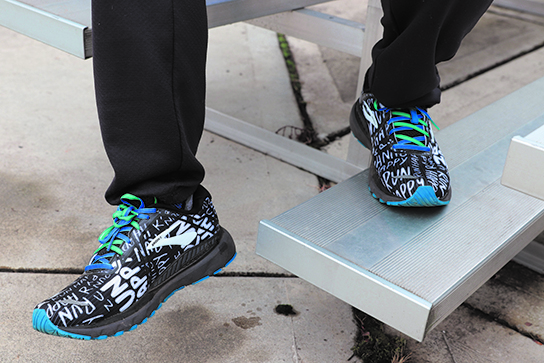
“These are them, the new ones,” he exclaimed while showcasing his kicks. “Everyone’s got to see the shoes. I like to wear Brooks because it’s the only shoe I found to help me be successful as a runner. They are the most comfortable – and I’ve tried all the brands.”
In addition to his fly feet apparel, Tyler unveiled his own personal brand during the Miracle Mile event. While making his strides towards his final mile, Tyler proudly displayed his new merch for all to see; a t-shirt, water bottle and a mask with his alias, ‘Tulalip Marathon Man’, in large text next to a silhouetted-logo of himself running.
“Running is important to me because it’s something I enjoy doing,” Tyler expressed. “I think it motivates people to start exercising in general. When people see me on the side of the road, it brings me motivation and excitement and it’s actually really cool when it happens in your own community. It makes me feel good and it’s really important to me. My advice to new runners is find something that motivates you to run and don’t push yourself too hard, you have to take it easy at first when you are learning how to run. Take it one mile and one day at a time, and remember that anything is possible.”
With 1,000 miles in the books and smoke-free weather, Tyler is ready to get back on his grind and is already conjuring up his next personal goal. The partnership with Leah’s Dream helped raise over $1,200.00 and the non-profit is still accepting pledges for the runners, although the event finished earlier than anticipated. The foundation will now focus their efforts on creating a magical Christmas for their children and community, assembling gift-care packages that will be hand-delivered to their homes by none other than Santa Clause.

“We want our families to know that we’re here, we care and we just generally want us all to be together again,” Deanna said. “We’re all within a community, we are all one and united, it doesn’t matter what disability or non-disability you have. Creating an inclusive environment is one of the biggest things we want, love and strive for.”
For more information about Leah’s Dream Foundation and the Tulalip Marathon Man, be sure to follow their journey on their respective Facebook pages.

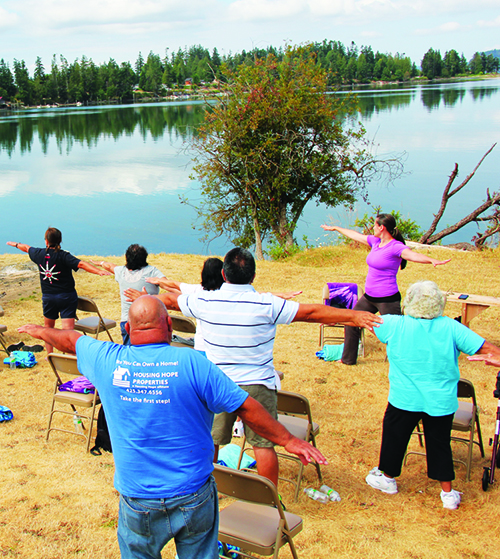
By Indian Country Echo; photos by Micheal Rios and Kalvin Valdillez, Tulalip News
In 2016, the Tulalip Diabetes Care and Prevention Program was awarded the Indian Health Service Portland Area Director’s Award for Excellence. Since then, the program has seen remarkable successes in treating patients and bringing the community together. In late March 2020, we had the pleasure of speaking with Veronica “Roni” Leahy- Diabetes Program Manager for Tulalip to learn more about their secrets to success.
Roni, who is a member of the Chiricahua Apache Tribe in New Mexico has worked in healthcare since the 1980s, explained to us that it was her father, who inspired her to work for tribal people. Since beginning at Tulalip, Roni has humbly viewed her role as someone who helps create spaces where community members can connect and feel that they are listened to and cared for by staff. She also sees it as her role to create a culture of care that is responsive to patients’ needs.
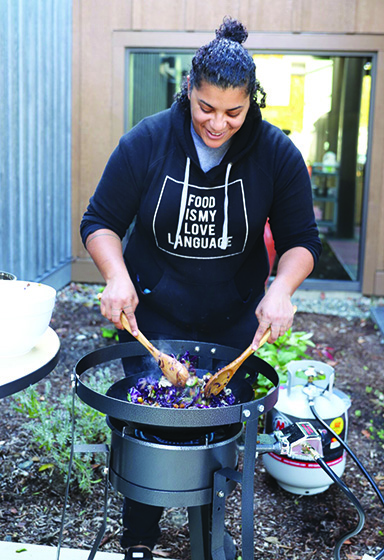
When Roni started in her position 12 years ago, the diabetes program was much smaller, consisting of only three full-time staff members. Shortly after, the Clinic’s leadership made sweeping changes that helped the program grow. Their first effort was to actively seek out and hire a dedicated Registered Nurse and Certified Diabetes Educator. Then, leadership put Tulalip’s Clinical pharmacists at the center of diabetes medication management by designating them as case managers. Additionally, through the diabetes team’s urging, the program and tribe began covering the costs for needed supplies and services for patients with diabetes, including medications, eye-exams, orthotics, physical therapy, chiropractic care, alternative medicine, dental care, and lab work not covered by insurance. Finally, the program began to expand outside of the clinic walls. With Special Diabetes Program for Indians (SDPI) funding, they created a wellness garden and trail and began to offer classes on herbal medicines, gardening, cooking, nutrition education, and wellness. Community members and their families began socializing, learning from one another and staff, and growing their toolbox of skills to take care of their health and the health of their loved ones.
Roni was delighted to see that when staff and community members interacted during diabetes program events real relationships and trust began to form. Roni believes that these relationships, as well as the program’s focus on engaging the whole community, have helped the program succeed.
Today, the Tulalip Diabetes Care and Prevention Program meets and, at times, exceeds the SDPI and IHS standards of care. It offers community member’s 1-on-1 support from diabetes case managers and the support of a coordinated care team of providers including – pharmacists, primary care doctors and advanced registered nurse practitioners, herbalist, acupuncturists, nurse educators, behavioral health specialists, optometrists, and podiatrists. It even has an Elder Advocate- a tribal member who is respected and valued as a spiritual person, who does home and hospital visits, oversees all program activities, and imbues program events with daily prayer and spiritual wellness. This person is Dale Jones, and he often will be heard saying “Every good thing starts with prayer and ends with prayer.”
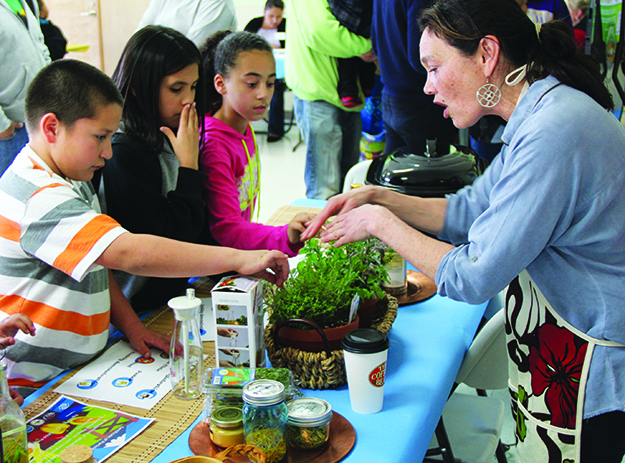
The program has seen remarkable success – a majority of patients with diabetes have an A1C of less than 8.0 as well as blood pressure readings of <140/<90, and almost all patients have received diabetes education. Roni credits the program’s successes to the vision of a committee of dedicated community elders who provide guidance. Through incorporating the wisdom of elders, staff work to implement consistent programming and regularly scheduled events, offer activities tailored for different age groups, and include as many community members as possible in growing the program. Finally, elders have encouraged Roni to develop a virtual walking journey that community members will take to the intended landing site of this year’s Canoe Journey. After receiving permission to make the journey to Snuneymuxw in British Columbia from the Snuneymuxw Chief and Council- Tulalip community members will join each other in counting their steps to “walk” the 340 miles.
Given the Tulalip Diabetes Care and Prevention Program’s commitment to building a culture of wellness, it is clear that their efforts will continue to take the Tulalip people far- one step at a time.
To Learn More about the Tulalip Diabetes Program please contact Veronica “Roni” Leahy at 360-716-5642 or at vleahy@tulaliptribes-nsn.gov
Please use the following link to download the September 19, 2020 issue of the syəcəb
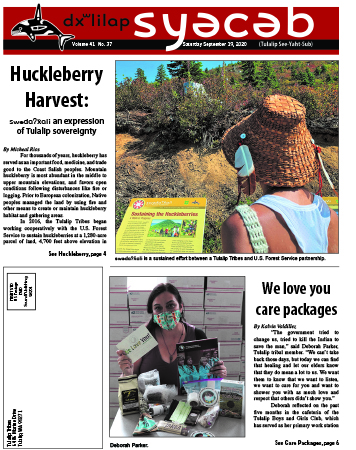
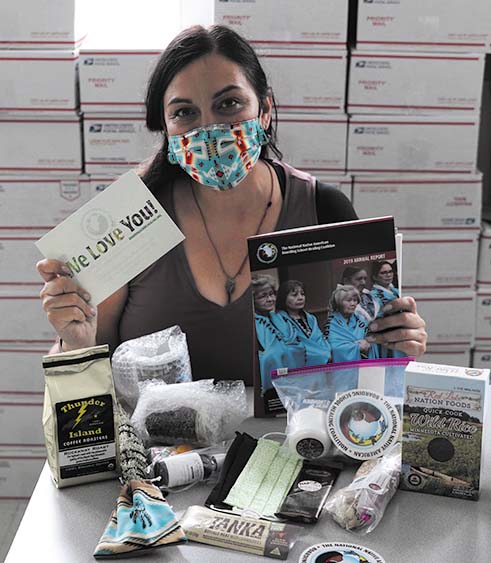
By Kalvin Valdillez, Tulalip News
“The government tried to change us, tried to kill the Indian to save the man,” said Deborah Parker, Tulalip tribal member. “We can’t take back those days, but today we can find that healing and let our elders know that they do mean a lot to us. We want them to know that we want to listen, we want to care for you and want to shower you with as much love and respect that others didn’t show you.”
Deborah reflected on the past five months in the cafeteria of the Tulalip Boys and Girls Club, which has served as her primary work station for the care package project. With a mountain of white USPS boxes behind her, she explained what one might expect upon opening one of the many boxes that were stacked neatly and nearly to the ceiling.
“1,000 boxes, that’s the ambitious goal,” she laughed. “We were trying to figure out what these boxes would be called and the words we came up with were just, ‘We Love You’. We want people to feel loved. Sometimes people go through life not knowing that someone loves them. The boarding schools made sure that our kids didn’t feel loved for who they were, who they are as Native Americans.”
Deborah of course needs no introduction, she is known nationwide for her work in Native America, using her voice for a number of causes, namely the Violence Against Women Act (VAWA). She was also handpicked to serve on the platform committee for Bernie Sanders during the 2016 Presidential Election. And just as important, Deborah has held a number of leadership positions locally for both the Tulalip Tribes and the Marysville School District. Her work extends beyond the US borders as well, working for the Tsleil-Waututh First Nation in Canada as the Director of the Residential Healing School early in her career, making her passion for providing healing for boarding and residential school survivors a lifetime commitment.
Last Fall, Deborah helped organize the 2nd Annual Boarding School Healing Conference at the Tulalip Resort Casino. The conference was hosted by NAB, or the National Native American Boarding School Healing Coalition, a non-profit founded in 2012 whose mission is to bring out the true history of boarding schools in America and residential schools in Canada, as it is often glossed over in textbooks, if mentioned at all.
“Our Native children were often put in schools and many never returned,” she explained. “We are currently fighting at the United Nations to bring back justice for the children and families who never returned home from the boarding schools.”
Assimilation brought on years of terror and abuse for Native children all across America. 367 boarding schools were established throughout the country in total, with 13 based in the state of Washington, including the Tulalip Indian School. The atrocities that occurred at the boarding schools in turn had a trickledown effect throughout the generations. Today, although several generations removed from the boarding school experience, the children, grandchildren and great-grandchildren of boarding school survivors are dealing with the aftereffects of the abuse that took place at the schools, trying to break the cycle of generational trauma that often appears as alcoholism and substance abuse, suicide, depression, poor diets, and domestic violence that stems from neglect, maltreatment and loss of identity caused by forced assimilation at the boarding schools.
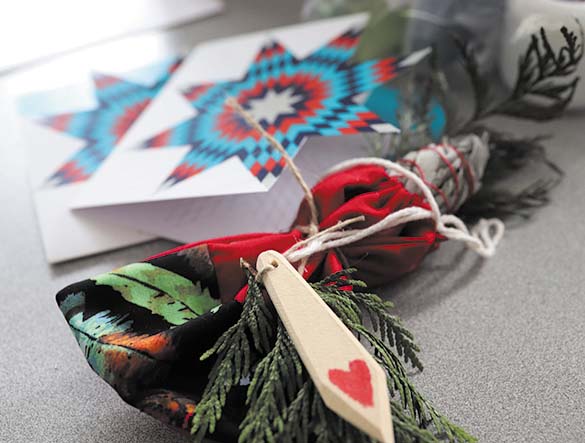
Although Deborah doesn’t have an official position with NAB, due to her personal connections and the desire to see residential school victims begin their healing process, she has been very involved with the non-profit’s recent activities, often volunteering to lend her voice, expertise and a helping hand whenever and wherever needed.
She said, “Back when COVID first hit, I asked who’s taking care of our elders? We just had a conference here at Tulalip and I met a lot of the elders and people who are just trying to process. I was concerned for them and their wellbeing. NAB had some funding that would’ve went to another conference, and since they didn’t spend the money, I started looking at products online for care packages. I started looking at how I could buy Indigenous.”
Taking it upon herself, Deborah began researching Native-owned businesses, compiling a wish list of products and companies she hoped to collaborate with. She reached out to these companies to gauge their interest in working together and their capability to fulfill large order requests during the coronavirus, many of whom were facing hard times as a result of the pandemic. In fact, many companies actually expressed that her business helped them immensely during this time of unknown.
“I realized that there are a lot of Native entrepreneurs and businesses that were really struggling, so I thought what a good partnership if we could send some of their beautiful items to the elders in need. This was a vision of creating a win-win situation between everyone involved, including NAB having the budget to support this effort.”

The next step, after purchasing products made by Indigenous creators from all across the country, was assembling the boxes. Knowing she could rely on her community, Deborah put out a call on Facebook and the volunteers showed up. Over the summer, community members of all ages leant a hand in putting together the care packages at the Boys & Girls Club, including Club members and staff.
“It’s been pretty fun, having the kids participate,” said Club Director, Mark Hatch. “Some of the basketball team kids come here and donate their time on the weekends and that’s pretty impressive. I think it’s really important work that Debbie and her team is doing.”
Tribal member Misty Flores and her kids have been volunteering their time to the care package project since the very beginning.
“We love working here,” Misty stated. “To be able to participate in this experience and help the elders is a once in a lifetime experience for us. In the last year I learned more about the boarding schools and what happened during those times. It’s really nice to be able to be a part of something so special and do something heartfelt for those people who had horrible things happen to them.”
Skylar Flores said, “It was a new exciting challenge to complete and it felt nice to help the elders who survived the boarding schools.”
Although she admits that curating each box requires more attention than she originally anticipated, Deborah expressed an extreme amount of gratitude for the volunteers and was beyond ecstatic when showcasing the contents of each box, noting that each package will be unique, as well as a surprise to the recipient.
“A lot of the products were harvested just for this and are sustainable,” Deborah said. “We have medicine bags that were handmade by Threads of Love, who went completely above and beyond to make every medicine bag special. The Native Wellness Institute sent us Native Wellness coloring books. We have the Three Sister seed-blend, from the Native American Agriculture Fund and the Flower Hill Institute. They sent us two cases of corn, beans and pumpkin seeds for elders to plant, and they also donated money to help us send the boxes out. The Native American Finance Officer Association, NAFOA, donated 1,000 chocolate bars that are from the Chickasaw Nation. It’s a really fine, delicious chocolate.”
She continued, “We purchased coffee from four different Native American Coffee Companies, so most of the boxes will have coffee. We have wild rice from Red Lake; Organic Huckleberry Jam by Rose’s Native Design from the Yakama Nation. From the Quinault Nation, Titus Capoeman and [Tootie James] made 1,000 Devil’s Club Salves and we have SovereigNDN Tea made by Jean Ramos. Amy Anderson (Tulalip) does the Salish Soaps. Puyallup donated 1,000 cedar roses, necklaces and beaded items. We have sweet grass lip balm, blackberry sage and sequoia candles. 1,000 paddle pendants handmade by a Chehalis tribal member and Cecily George painted hearts on each paddle.”

Deborah stated that although it was important to order locally, she also wanted to include items from as many sovereign nations that she could, including tribes based in Alaska, Oklahoma, Piute, South Dakota and New Mexico. Tulalip tribal member Sarah Hart, was called upon to add her contributions to the project. Sarah is known by the local community to carry sage and perform blessings and cleansings for people prior to gatherings and events. Sarah provided her potent, homemade hand sanitizer for the care packages, as well as sage that she journeyed to California to harvest.
“To know where the boxes are going touches your heart in such an unexplainable way,” Sarah said. “I have heard stories my whole life from elders, my grandma and family about boarding schools and the horror stories. To be a part of this is a real honor, to give them a little bit of medicine and remind them that we love them and without them, we wouldn’t be who we are today. They have sacrificed the ultimate pain and we owe them our prayers and love. It was emotional for me to have some of our youth [assemble care packages], including my son. Deborah explained, when the first boxes were made, what they were and what that meant. At the moment, everyone felt so much emotion in that room. To know my sanitizer and the medicine will go to a boarding school survivor is the ultimate honor.”
Deborah and her family also did a bit of harvesting of their own for this occasion, and out of their harvest they created a medicinal spray that helps ease tension and anxiety.
“One is sage, cedar, sweet orange and lavender, it’s called medicine bundle,” Deborah explained. “It took about a week of harvesting and distilling. We had Misty, her children, Colette from Northwest Indian College, and the [Boys & Girls Club’s] boys’ basketball team help with filling the bottles. We probably have about 600 bottles done. It took one whole day just to put the fluid in the bottles, cut the sticker and put them on the bottle and in a bag so they’re ready to go.”
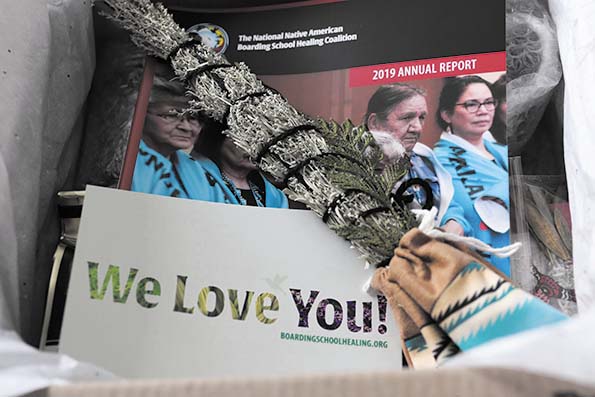
Although the grand total of care packages is 1,000, Deborah and the group of volunteers will be shipping out 150 boxes at a time. In addition to the items Deborah listed, the boxes may also include N95 or cloth masks, Red Corn Frybread dough, Eighth Generation socks, Native Wellness Life Magazines, and a We Love You card with instructions for the elders on how to share photos of their care packages on their social media, and additional information about the real history of boarding schools in North America.
“Starting this project was just a labor of love,” Deborah expressed. “It meant a lot to me for the elders to know that we care about them. Some of these ideas may seem off the wall like, ‘you’re just buying products, what does that have to do with Native people?’ It’s our survival, it’s our commerce, it’s how we take care of our elders. Because our families were separated, our children were removed, taking care of each other has been a challenge at times. We lost many of those skillsets that we once had, so getting back to the love, getting back to nurturing, getting back to community is one of our greatest needs in Indian Country.”
If you are looking to volunteer your time or are searching for my details, please contact Deborah Parker via Facebook or visit www.BoardingSchoolHealing.org
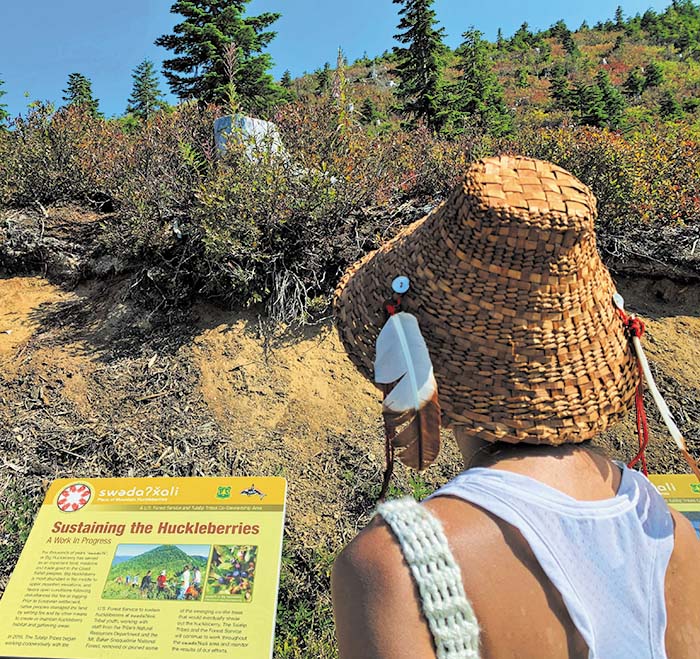
By Micheal Rios, Tulalip News
For thousands of years, huckleberry has served as an important food, medicine, and trade good to the Coast Salish peoples. Mountain huckleberry is most abundant in the middle to upper mountain elevations, and favors open conditions following disturbances like fire or logging. Prior to European colonization, Native peoples managed the land by using fire and other means to create or maintain huckleberry habitat and gathering areas.
In 2016, the Tulalip Tribes began working cooperatively with the U.S. Forest Service to sustain huckleberries at a 1,280-acre parcel of land, 4,700 feet above elevation in the upper Skykomish River watershed. This particular location is one of several co-stewardship areas throughout the Mt. Baker-Snoqualmie National Forest where Tulalip collaborates with the Forest Service to preserve and maintain important cultural resources.
Named swədaʔx̌ali, Lushootseed for ‘Place of Mountain Huckleberries’, this end of summer destination gives Tulalip tribal members an opportunity to walk in the shadows of their ancestors and harvest the highly prized mountain huckleberry. The gate to swədaʔx̌ali was officially opened on August 25 and will remain open through the end of September.
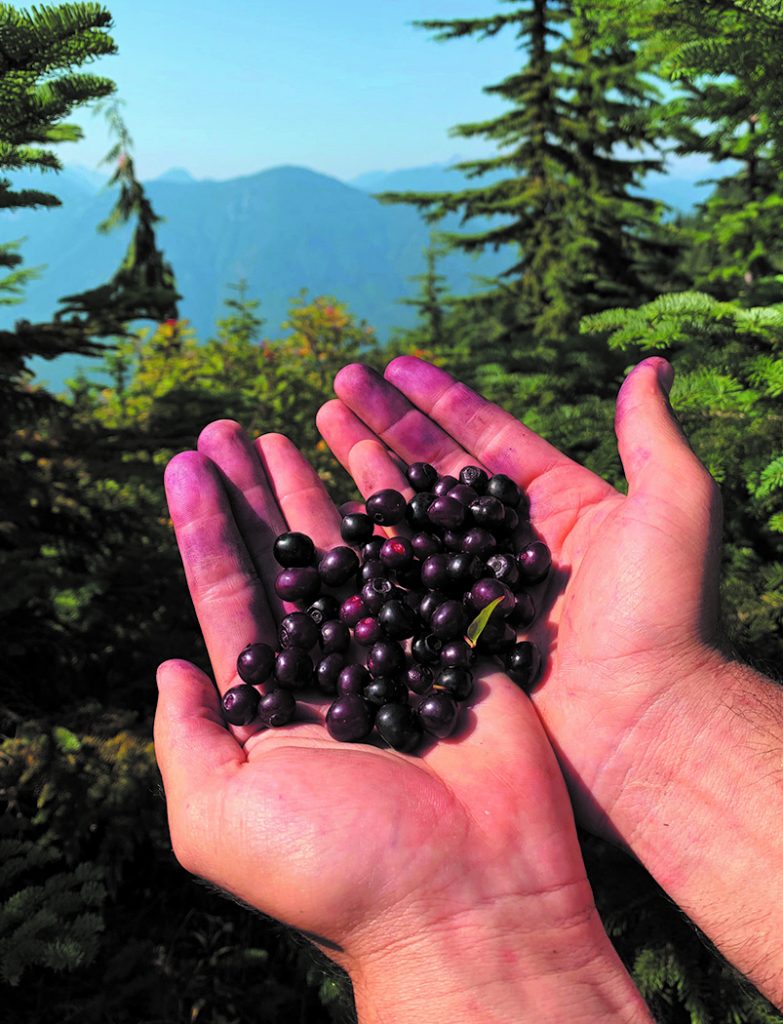
Northwest mountain huckleberries generally ripen in the late summer and can be picked into the early fall. Huckleberry, well-known for boosting the immune system and being rich in antioxidants, has always had a strong relationship to the area’s Indigenous cultures. Coast Salish tribes consider the huckleberry to be an important dietary staple because of its medicinal properties and sweet, delicious taste.
“Huckleberry is a food and medicine to our people,” explained Tulalip elder Inez Bill. “Our ancestors visited certain areas for gathering these berries. They knew where the berries were growing, what companion plants were growing there too, and how to use them.
“Through the teachings of how we value, take care of and utilize our environment, we pass down our history and traditions, and what is important to the cultural lifeways of our people,” she continued. “This connection to the land enables us to know who we are as a people. It is a remembrance. Today, it is not only important that we continue the struggle to uphold our treaty rights, but we need to be involved in taking care of those resources our culture depends on so they will be available to future generations.”
swədaʔx̌ali is a prime example of how Tulalip is diligently working to reclaim traditional areas. Stemming directly from the Point Elliot Treaty, which secured claims to gather roots and berries in all open and unclaimed land, the ‘Place of the Mountain Huckleberries” is an expression of Tulalip’s sovereignty.
Embracing that sovereignty is every tribal member who journeys to this ancestral harvesting area and practices their cultural traditions that continue to be passed on from one generation to the next. Tulalip mother-daughter duo, Malory Simpson and Tiyanna Bueno, have made the two-hour trek to harvest huckleberry twice so far, and plan on going once more before the gate is closed for the season.
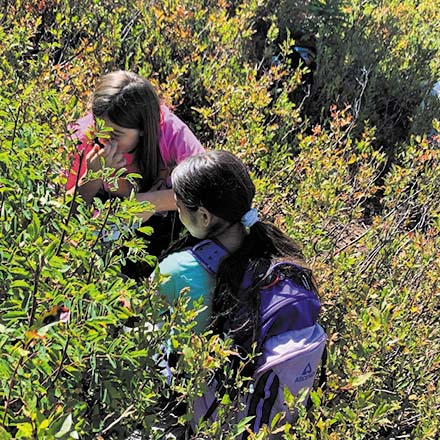
“I love being outdoors and harvesting. It is spiritually healing,” reflected Malory after collecting her berry bounty alongside her 9-year-old daughter. “It feels good knowing that my children are learning about our harvesting traditions with me. I want them to not only have a good understanding of how to harvest, but how to properly process what they’ve harvested, too.
“It’s important for our children to soak up teachings about how to harvest, process, and be self-sustaining in a good way,” the mother of three continued. “My plan for our harvest is to make some jam. We’ll be enjoying huckleberry pancakes and waffles as well. We’ll also be gifting some of our harvest for spiritual work.”
For the Tulalip Tribes, the mountain huckleberry is intimately tied with traditional lifeways and culture. Historically providing an end of summer harvest opportunity, the journey to swədaʔx̌ali strengthens a deep connection to the land as well. Nearly 5,000 feet up, in the Mt. Baker-Snoqualmie National Forest, berry pickers are completely immersed in the grand splendor that is the Pacific Northwest. Epic views of luscious, green-filled forestry, towering mountains, and clear waterways are purely mesmerizing.
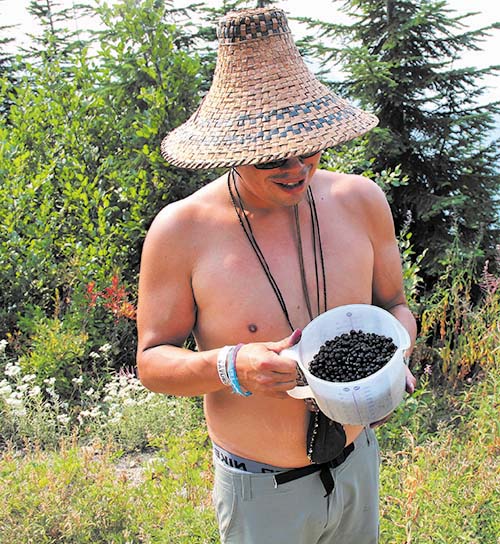
“It was a beautiful, uplifting experience. Once we hit the forest, where there were no buildings, no cars, no people, just trees…my spirit soared,” said Lushootseed teacher Maria Martin after staining her hands purple from a day of picking. “I’m fortunate to have the opportunity to speak my language, but that is only a piece of my culture. Berry picking feels natural, like I’ve always done it. The smells are intoxicating. The sounds are beautiful, from the buzzing bugs and chirping birds to the gentle breeze rustling the huckleberry leaves. These are the meaningful experiences that we all need to share in.”
Mountain huckleberry season is short, lasting only a few weeks between August and September. The sought after super food and medicine ranges in color from red to deep blue to maroon. They are similar to a blueberry and sweeter than a cranberry, with many people rating huckleberries as the tastiest of the berry bunch. The gate to swədaʔx̌ali will only remain opened for a couple more weeks, so don’t miss the opportunity to harvest, take in breathtaking views, and, most importantly, express tribal sovereignty.
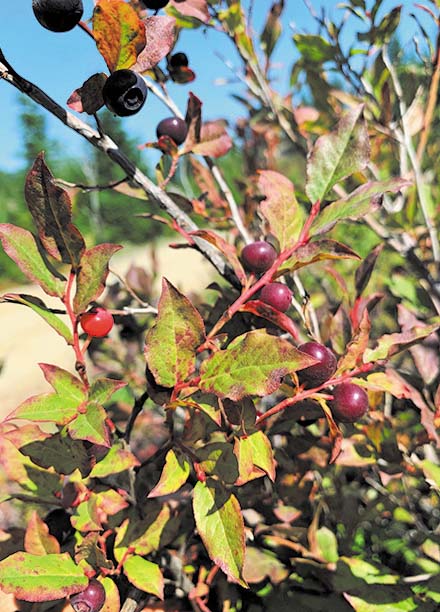
Huckleberry Health Benefits:

My name is Teri Gobin, and I’ve had the honor of being your Chairwoman since 2019. As Chairwoman, I have represented this tribe and defended our rights and interest at all government levels. I thank you all for the opportunity to continue that work.
All elections are important, but this Presidential election will decide what kind of Nation we will have for many years to come. Are we a nation of greed, distrust, and selfishness, of lies and division? Or, are we a nation that comes together at a challenging time and shows a united fight for equality, justice, and the next seven generations? Those are the questions before us today.
Donald Trump stands for weakening environmental protections like the Endangered Species Act, which helps us protect salmon vital to our culture, lifeways, and tribal economy. The Trump Administration has weakened water standards to allow more cancer-causing chemicals into our Salish Sea and our traditional foods.
Trump approved the Dakota Access and Keystone XL pipelines, which threaten the water supply and treaty and trust resources for tribes and ignores tribal sovereignty and government-to-government relationships. This administration also removed the Mashpee Wampanoag Reservation land, which has threatened the security of all tribes.
Additionally, Trump has cozy relationships with white supremacists and total disregard for the murders of BIPOC (black, indigenous, and people of color) at the hands of police. His ignorance of the problem of systemic racism in our society has disproportionately left BIPOC out of the American dream.
Since the beginning of time, our people have lived here. Our ancestors made great sacrifices to protect our tribal culture and lifeways. Joe Biden has a different vision for America, and it’s one where our values and our people are welcome.
Joe Biden authored the original Violence Against Women’s Act and in 2013 advocated for tribe’s rightful authority to protect native women through its reauthorization
As VP, Biden helped settle the Cobell settlement for $3.4 billion, creating the land buy-back program which restored millions of acres of land to tribal governments
The Affordable Healthcare Act helped provide health care coverage for over 110,000 Native Americans
As VP, the Obama administration made significant progress in strengthening the nation-to-nation relationship between the federal government and tribes and supported tribal sovereignty
Biden will immediately reinstate and make permanent the White House Council on Native American Affairs and the annual White House Tribal Nations Conference. He will also nominate and appoint people who look like the country they serve, including Native Americans.
Biden will make it a priority to restore tribal lands and protect the natural and cultural resources within them while honoring the role of tribal governments in protecting those resources. Joe will work to take land-into-trust and support tribal water rights.
On day one of the Biden Administration, he will issue executive orders to protect biodiversity, slow extinction rates, and leverage natural climate solutions by conserving 30% of America’s lands and waters by 2030. Biden will protect America’s natural treasures by permanently protecting the Arctic National Wildlife Refuge and other areas impacted by President Trump’s attack on federal lands and waters. Additionally, he plans to establish national parks and monuments that reflect America’s natural heritage. Including reversing President Trump’s proclamation on Bears Ears, which reduced two million acres of federally protected land at two national monuments in Utah.
As we look around at the smoky air, the diminishing salmon runs, and the loss of cultural places, we see that Indian Country and THIS country cannot afford four more years of Donald Trump’s corporate greed and divisive rhetoric. Let us set a new path toward healing the earth and ourselves.
For those of you who are not registered to vote, please do so now. It takes only a few minutes online. Indian country counts, your voice counts!
Go to www.vote.org/ OR votewa.gov
It is so important to vote. Our future depends on it.
